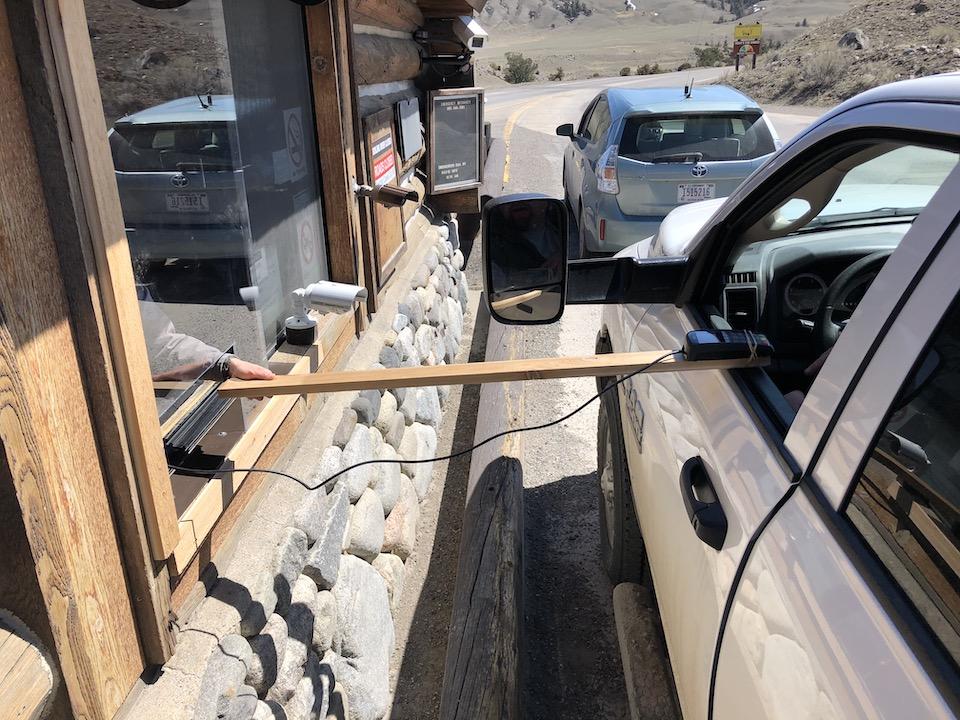
National parks are developing new practices for coping during the coronavirus pandemic, like distancing gate workers from visitors/NPS
When the gates to national parks swing open in the coming weeks, expect to find initial restrictions as to what you can do and where you can go, restrictions that will be eased based on the current coronavirus status. In some cases, states might require non-residents arriving for non-work-related purposes to self-isolate for two weeks.
At Bighorn Canyon National Recreation Area in Montana and Wyoming, as well as the Little Bighorn Battlefield National Monument in Montana, staff from the two units have been developing reopening plans for their parks.
Both parks are looking at a three-phased process for opening. The plan will include phased reassessments of conditions and modifications of operations, and gradual increase of access to parks in accordance with federal, state and local public health guidance and in coordination with the Interior Department, a park release said.
"The parks are committed to working with state and local officials to reopen both sites in a safe manner," it went on. "In the same way decisions were made to close certain aspects of both parks, the incident command team is performing risk assessments for opening the parks. In addition to CDC guidelines, the risk assessments look at supplies, increased sanitation, and staffing."
Currently, as is the case with many parks, the return of some permanent and summer seasonal staff has been delayed at the two parks, and the possibility exists that hiring may be suspended for the 2020 summer season. Additionally, many staff at both parks are currently working from home. This impacts the number of employees available to staff visitor centers and impacts park projects and facility maintenance activities, all of which is taken into consideration as part of the phased opening decision-making process.
Both Gov. Mark Gordon of Wyoming and Gov. Steve Bullock of Montana continue to support guidance "requiring any individual coming into their states for non-work-related purposes to self-isolate for 14 days," the parks' release said. "These directives are to discourage out-of-state visitation, reduce strain on resources, protect health care workers during the pandemic and reduce the spread of COVID 19."
At Yellowstone National Park, park staff will be tracking the flow of visitors into and out of public facilities.
"There are businesses doing this very successfully right now in the middle of this pandemic. We are taking a lot of mitigation actions from the private sector, actions that have been proven to reduce exposure to employees," Superintendent Cam Sholly said. "We will have proper mitigation measures in place prior to opening particular facilities. If we can't protect them, we won't open them. I'm impressed with the ideas and innovation of the Park Service team here, and our partners, in coming up with methods for protecting each other, and allowing for visitors to begin accessing the park again. We are involving these employees in conversations around what can help make the safer to potential exposure. This work is continuing."
The Yellowstone superintendent reiterated what he said last week about expecting visitors to police themselves when it comes to maintaining social distancing.
"I'll hope the general public follows health guidelines around social distancing, but if they don't, I can guarantee we're not putting NPS employees into the middle of large crowds." Sholly said. "We will do our best to communicate with the public to take personal responsibility, but we will not have employees out there telling people to spread out or anything like that. In other words, if the public wants to put themselves at risk, that doesn't mean NPS employees need to be exposed to that same level of risk.
"I'm mostly referring to outside areas where we literally can't control where people go or congregate," he said. "For example, how do you control 11,000 people per day on the Old Faithful boardwalk, that is basically accessible 360 degrees around, no control point where you could meter visitors if you wanted?"
At Wrangell-St. Elias National Park and Preserve in Alaska, staff put together an FAQ page for visitors. One of the questions revolves around public restrooms along the McCarthy Road and elsewhere in the park.
"We are in the process of evaluating a timeline and outcome for each of the more than 60 restrooms we maintain. A press release detailing restroom availability and cleaning frequency will be shared on or before May 5th. It is our goal to open as many restrooms as possible," the FAQ page explained.



Comments
Steven, back on April 28 we ran an article in which Yellowstone Superintendent Cam Sholly said the park would open before June 15. That said, they have not given a specific date.
https://www.nationalparkstraveler.org/2020/04/details-beginning-surface-...
Golly, that comment motivated me to go back through my notes and files. Wow, Cam Sholly has said quite a lot of things; some of them even drove people to make clandestine cellphone records.
Incorrect. The two parks I visit the most, Shenendoah and Assateague remain closed as of 5/5/20.
Kellie,
I too have been home since March 3 & take the recommended precautions. Last week I decided to take a road trip around MT then onto Idaho-which is reopening also-then onto eastern WA. At no point was I stopped, questioned or told to 'quarantine' anywhere. I encountered folks equally dedicated to staying safe-I experienced nothing but examples of how well the precautions are working!
I say travel freely, safely & happily-as long as the Park is open that is!